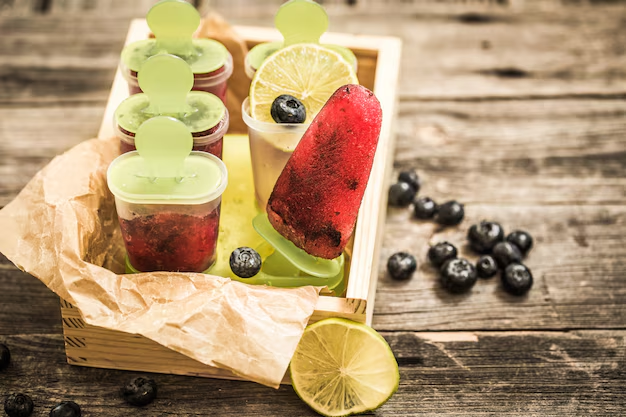How Long Does Jelly Really Last in Your Fridge?
Picture this: You wake up on a lazy Sunday morning, craving a slice of toast slathered in that sweet, fruity jelly tucked away in your refrigerator. But just as you're about to satisfy your craving, a daunting question arises: How long has this jelly been sitting in your fridge? No one wants to risk spoiled food, but as a common household staple, understanding the shelf life of jelly is essential for both safety and taste. Let's dive deep into the delightful world of jelly storage to keep your breakfast spreads safe and scrumptious!
🥄 Understanding Jelly’s Shelf Life
Jelly, a beloved companion to peanut butter and toast, is more than just a sugary delight. Properly understanding its shelf life can help preserve its flavor and prevent food waste. Here's a breakdown of factors that influence jelly’s lifespan in your refrigerator.
📅 Expiration Dates vs. Shelf Life
Expiration Date: Usually found on commercial jelly jars, this date indicates when the product is at its peak quality, not when it expires. Consuming jelly past this date doesn’t necessarily mean it's unsafe, but the flavor and texture might not be at their best.
Homemade vs. Store-Bought: Store-bought jelly is typically pasteurized and contains preservatives, giving it a longer lifespan. Homemade versions might be more prone to spoilage without added preservatives.
🍇 Ingredients Influence Longevity
Jelly consists mainly of fruit juices, sugar, and pectin. But variations in ingredients can alter how long it stays fresh:
- Sugar Content: High sugar content acts as a preservative. Low-sugar or sugar-free jellies might spoil quicker.
- Pectin: Natural pectin or commercial pectin can affect consistency and, occasionally, preservation.
🏡 Storage Conditions Matter
Two main factors play a role in jelly’s freshness in the fridge:
- Temperature: Maintain a consistent refrigerator temperature, ideally below 40°F (4°C), to slow bacterial growth.
- Container Seal: Always ensure the jelly is stored in airtight containers to prevent moisture and air penetration, which foster mold growth.
👁️ Recognizing Signs of Spoilage
Before we explore the storage tips, it’s crucial to understand how to identify spoiled jelly. Knowing what to look for will save you from potential foodborne illnesses.
🦠 Visible Mold and Odd Smells
- Mold Growth: If you spot mold—even if it's just on the surface—consider it spoiled. Mold spreads quickly, even if it’s not visible to the naked eye.
- Off Odor: Any strange or sour smells are clear indicators that your jelly has gone bad.
📏 Texture Changes
Jelly should be even and smooth. Watery, clumpy, or overly sticky textures suggest spoilage or separation, especially in natural or homemade varieties.
🏠 Best Practices for Storing Jelly in the Fridge
Ensuring optimal storage practices can help you extend the life and quality of your jelly. Here’s how you can keep your jelly fresh for as long as possible.
🥶 Fridge Storage Tips
- Consistent Temperature: Place jelly on a middle or lower shelf in the fridge where temperatures remain consistent.
- Avoid Fridge Door: The fridge door experiences higher temperature fluctuations, which can speed up spoilage.
- Proper Sealing: Always use airtight lids or covers after opening to maintain airflow and protect from contaminants.
🚫 What to Avoid
- Using Wet Spoons: Moisture introduces bacteria. Always use dry utensils when serving jelly.
- Cross-Contamination: Use a clean spoon every time to prevent residue from contaminating the jelly. Avoid using the same spoon for peanut butter or other spreads.
🔍 Comparing Preserved vs. Homemade Jellies
Store-bought, preservative-laden jellies do offer the advantage of longevity, but homemade options bring fresh flavors. Here’s what to anticipate with both.
🏪 Store-Bought Jelly
- Preservatives: Extend the lifespan but can impact natural flavors.
- Uniform Consistency: Provided by stabilizers, ensuring a pleasant texture throughout.
- Proper Storage: Typically lasts several months in the refrigerator once opened.
👩🍳 Homemade Jelly
- Fresh Taste: Often more flavorful but may vary in texture without additives.
- Shorter Shelf Life: Without preservatives, they usually last around a month in the fridge.
- Vacuum Sealing: If properly canned and sealed, durations can extend, though opened jars should follow strict fridge storage practices.
📚 Quick Reference: Jelly Storage Cheat Sheet 📋
Here's a handy reference to help you keep track of storing your jelly like a pro:
| Jelly Type | Predictable Shelf Life | Proper Storage Tip | Signs of Spoilage |
|---|---|---|---|
| Store-Bought | 6-12 months (opened) | Store in middle/lower fridge shelf | Mold, odd odors, discoloration |
| Homemade | 1 month (opened) | Use airtight jars | Watery, off texture, mold |
🌟 Preserving the Sweetness: Future Considerations and Sustainability
With a focus on reducing food waste and improving sustainability, considering how you store jelly is just the beginning.
🌎 Sustainable Practices
- Small Batches: Try making or purchasing jelly in smaller quantities to ensure it’s consumed fresh.
- Recycling Jars: Once finished, many store-bought jelly jars can be reused for storing other pantry items, promoting an eco-friendly cycle.
- Labeling: Mark dates when you open jars to keep track of their age and prioritize older jars.
🤝 Community Approach
- Sharing Excess: If you’ve made too much jelly, consider sharing with neighbors or involving local food banks to limit wastage.
- Community Workshops: Engage in or organize events where people can learn about sustainable preservation techniques.
Effective food storage has more broad-reaching implications than just personal consumption. By taking mindful approaches toward jelly and similar food items, you not only enhance your own dining experience but also contribute positively toward global sustainability efforts.
As we’ve explored, keeping jelly fresh and delicious isn’t just a matter of checking expiration dates. Through proper storage techniques and being vigilant of spoilage signs, you can savor the sweetness of jelly while contributing to broader food sustainability efforts. Let each jar be a delightful, waste-free experience! 🥄🍇
